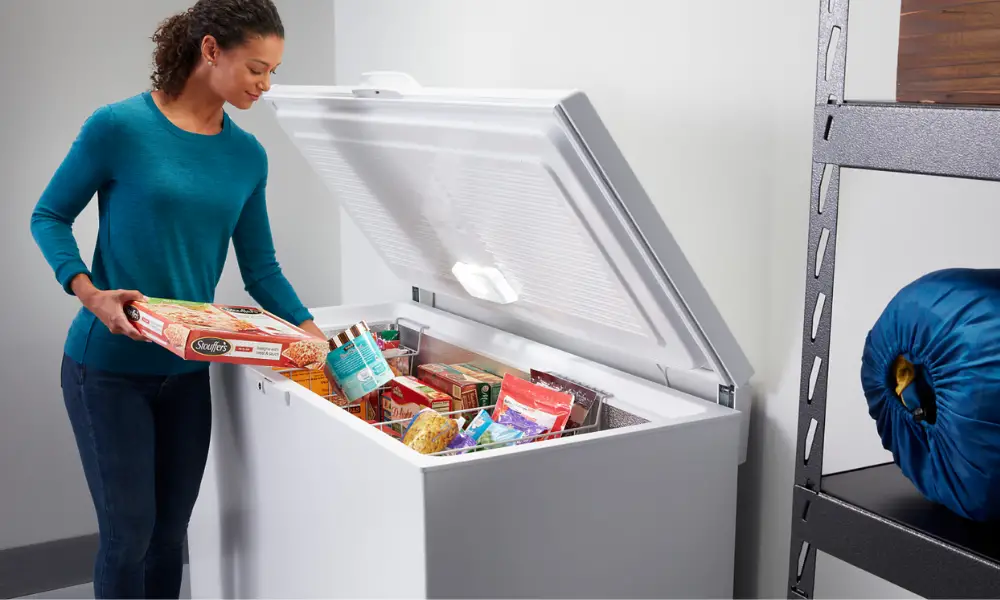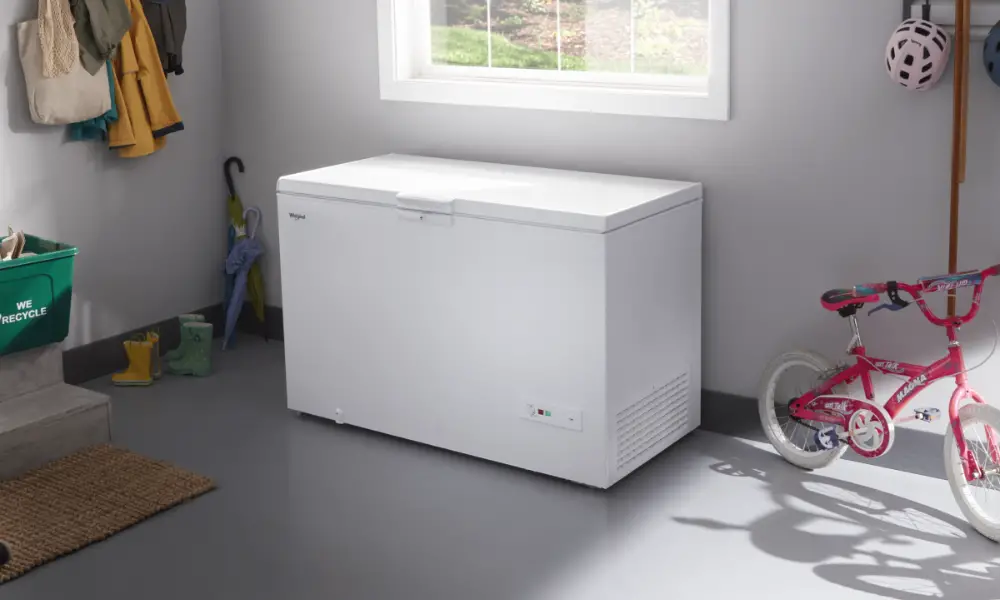You’re not alone if you wonder how long a chest freezer will stay cold without power. It is common knowledge that your freezer will maintain its normal temperature for about 48 hours after a power outage. However, you can do a few things to help ensure that your freezer stays cold for even longer.
There are several ways to keep food safe in a chest freezer during power outages. The first and most important step is to ensure you know how long your freezer will last before it is unsafe to consume. Keep a thermometer handy. If you don’t have one, buy one. It can be used to check the temperature of your food. You can also get a digital probe thermometer. This thermometer will puncture the wrapping of the package and help you to determine whether or not the food is safe.

What is a Chest Freezer?
Like a chest or box, a freezer that can be opened from the top is called a chest freezer. Compared to upright freezers, chest freezers have a variety of benefits. They often have a hinged cover that opens upward and is wider and shallower than upright freezers.
They save more energy: Chest freezers need less energy to keep a constant temperature since they have less exposed surface area.
They are more suitable for lengthy storage: Chest freezers are preferable to upright freezers for long-term storage because the bottom of a chest freezer maintains a colder temperature than the top of an upright freezer, even when the lid is opened.
They take up less room: Chest freezers take up less room than upright freezers because they have more storage space.
They have greater versatility. Chest freezers can be used for various things, including the storage of frozen meals, the creation of ice, and the storage of frozen fishing bait.
They are more economical: Chest freezers generally cost less than upright freezers.
It’s vital to remember that chest freezers require more effort to retrieve products than upright freezers because you have to sift through the contents to discover what you’re looking for. However, chest freezers generally are an excellent choice for people who require additional freezer capacity and want to reduce their energy usage.
How Long will a Chest Freezer Stay Cold without Power?
The temperature of the freezer, the quantity of food kept there, and the insulation of the freezer are some of the variables that affect how long a chest freezer will remain cold without power.
The chest freezer will remain cold for longer if it is fully stocked with frozen food instead of if it is empty or only partially packed. The temperature of an empty chest freezer will deteriorate significantly more quickly. Food can stay frozen in a full chest freezer for up to two days without electricity.
How long the freezer will keep cold is also influenced by its insulation. Compared to a chest freezer with lesser insulation, one with thicker insulation will maintain its frigid temperature for a longer time.
Before the power interruption, the freezer’s temperature was crucial. A chest freezer with a lower temperature setting will maintain its colder state longer than one with a higher setting.
It’s crucial to remember that if there is a prolonged power outage, you should check the food in your chest freezer and throw out any that has thawed or gone bad. Keeping a thermometer in the freezer is a smart idea to check the temperature when the power goes off.
How to Keep your Freezer Cold as Long as Possible After Losing Power?
Following a power outage, you can follow these procedures to keep your chest freezer as cold as possible:
- Keep the freezer closed: Limit how often you open the lid because the more you do so, the more cold air will leave.
- Add ice packs: Adding ice packs or bags of ice to the freezer will aid in maintaining a cool interior temperature.
- Keep the freezer full: A full freezer will maintain its temperature longer than an empty one, so attempt to fill any space with jugs of water or ice bags.
- Wrapping the freezer in blankets or towels might assist in keeping the cold air inside by insulating it.
- Keep the freezer in a cool part of your home: If at all possible, keep the freezer in a basement or garage.
- Utilize a generator: If you have access to one, you can utilize it to keep the food frozen by powering the freezer.
- Move food to a neighbor’s freezer: If the estimated duration of the power outage is long, you may want to consider moving some of your frozen food to a neighbor’s freezer.
It’s crucial to regularly check the temperature of your freezer and toss any food that has defrosted or gone bad. Food that has been kept above 40°F for longer than two hours should be thrown out.
Reference: Improving temperature uniformity in a large frost-free chest freezer
This study examined the homogeneity of cabinet temperature in a sizable frost-free chest freezer with an internal volume of 800 L. Two optimization techniques were suggested to improve the temperature uniformity in the freezer cabinet after analyzing the flow field and temperature field of the freezer through numerical simulation: redesigning the structure of the supply air channel to improve the airflow and optimizing the position of the supply air outlets and return air vents to adjust the airflow direction.
What to Eat First During a Power Outage?
To avoid wasting any food during a power outage, it’s crucial to give your freezer and refrigerator top priority.
- Eat perishable foods first: Meat, poultry, fish, dairy products, and eggs should be consumed first because they are more perishable. Without adequate refrigeration, these goods might quickly go bad. Here are some suggestions for what to eat first, in general:
- Next, use frozen food: The following food items are frozen fruits, vegetables, and meats. These meals should be consumed within a day or two of the power outage even though they will keep frozen longer than perishable products.
- Consume canned products last: Because they have a longer shelf life, canned goods such as fruits, vegetables, and meats can be consumed last.
If you have food that is almost about to spoil but is still safe to eat, prepare it and consume it as soon as possible.
Food that has been kept above 40°F for longer than two hours should be thrown out.
It’s critical to keep safety in mind during a power outage; it’s necessary to keep in mind. If a food item has an odd flavor, texture, or color, or if you suspect it may have been contaminated, avoid eating it.
Few Tips for Preserving Food in the Chest Freezer with no Power
Foods that can be frozen should be done so to increase their shelf life, including bread, eggs, fruits, and vegetables.
By paying attention to these suggestions, you may minimize wastage and preserve your food during a power outage. Additionally, it’s crucial to regularly check the temperature of your refrigerator and freezer and toss any food that has defrosted or gone bad.
Following are some recommendations for keeping food fresh during power outages or when one is anticipated:
- Keep your refrigerator and freezer full since they’ll keep cooler for longer than empty ones. If you anticipate a power loss, fill empty freezer spots with water or ice bags.
- The more often you open the freezer and refrigerator doors; the more cold air will leave; therefore, try to open them as little as possible.
- Move food to a neighbor’s freezer: If the estimated duration of the power outage is long, you may want to consider moving some of your frozen food to a neighbor’s freezer.
- Utilize a generator: If you have access to a generator, you may use it to keep food frozen by powering your freezer and refrigerator.
- Prepare ice packs: Having ice packs or bags of ice available can assist in maintaining a cool interior temperature in your refrigerator and freezer.
- Keep the freezer in a cool part of your home: If at all possible, keep the freezer in a basement or garage.
- Use a thermometer: Keep a thermometer in your freezer or refrigerator to check the temperature when the electricity returns.
How to Identify the Food in the Chest Freezer has Gone Bad?
The following are some indications that food in the refrigerator has spoiled:
- Visible mold: If you see mold, you know the food has gone rotten. On the surface of the meal, it can take the form of a white, blue, or black fuzz.
- A strong, unpleasant odor will emanate from food that has gone rancid. Food should be thrown away if it smells sour or stale.
- Food spoilage can be detected by its color. Food that has gone bad could become discolored. For instance, eating beef that has become brown or grey is unsafe.
- Slimy texture: Stale food may take on a slimy texture. For meats and seafood, in particular, this is valid.
- Food in the canned form that has gone rotten may bloat or leak, as evidenced by the cans. This suggests that the food within the can has gone bad or broken.
- Date of expiration: Always check the date on the food packaging; if the date has passed, the food should be thrown away.
- It’s crucial to routinely inspect your refrigerator and eliminate any food that appears to be going bad. By doing this, you can guard against food poisoning and guarantee that your food is safe and nutritious.
Side Effects of Consuming Food that is Spoiled when Kept in the Chest Freezer with no Power
Several negative effects can result from eating defective food that was kept in an unpowered freezer, including:
- Food poisoning: Food tainted may include dangerous pathogens, including Salmonella, E. coli, and Listeria. Food poisoning symptoms include diarrhea, fever, nausea, and vomiting.
- For example, those who are allergic to shellfish or nuts may experience an allergic reaction to some types of damaged food. An allergic reaction can cause hives, itching, swelling, and breathing difficulties.
- Abdominal pains, bloating, and diarrhea are just a few gastrointestinal problems resulting from eating rotten food.
- Toxins: Some forms of rotten food, such as mushrooms and some varieties of fish, may contain toxins that, if taken, might result in major health issues.
It’s significant to remember that these consequences apply to any ruined food, not just those kept in a freezer without power. When power is restored, always check your freezer’s temperature and throw away any food that has defrosted or gone bad. Additionally, it’s crucial to always adhere to proper food handling procedures, such as washing your hands before handling food, separating cooked from uncooked food, and cooking food to the proper temperature to reduce the risk of foodborne illness.
Conclusion
Food is safe after a power outage below 45 degrees Fahrenheit. It is important to note that temperatures above this level can also spoil foods. Leaving food at room temperature for longer than two hours can lead to the rapid growth of bacteria, which can cause foodborne illnesses.
When you are checking the temperature of your food, you should use a thermometer. An appliance thermometer can be useful for checking the freezer and refrigerator temperatures. A refrigerator can hold food at an appropriate temperature for about four to six hours.
